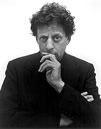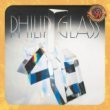Philip Glass
(1937- )
Although he has never achieved great critical success, Philip Glass has had major influence not only within classical music but also in the fields of popular music and culture. In 1997, the TV show South Park famously featured a “happy, non-offensive, non-denominational Christmas play, with music and lyrics by New York minimalist composer, Philip Glass.” Nor was South Park alone in parodying Glass’s famously repetitive style: part of Glass’s own official website, www.philipglass.com, is devoted to Glass jokes.

Youth
Philip Glass was born on January 31, 1937, in Baltimore, Maryland. His early education in music began with the classical records sold in his father’s radio repair shop, as well as with violin lessons, started when he was six years old. Flute lessons at the Peabody Conservatory followed when Glass was eight. Four years later, he began composing.
At the age of fifteen, Glass left high school and began attending the University of Chicago, where he studied philosophy and math. During his time in Chicago he had piano lessons and continued composing. In addition, he spent one summer abroad studying French in Paris. In 1956, after earning his bachelor’s degree in liberal arts, Glass attended extension classes at the Juilliard School in New York. He returned home to earn the money for his full-time enrollment, working as a crane operator for Bethlehem Steel. He finally entered Juilliard’s composition program in 1957.
Further Education—Juilliard and Paris
At Juilliard, Glass moved away from the twelve-tone techniques that had characterized his early efforts. Instead, he was attracted to the styles of unconventional composers such as Charles Ives, Harry Partch, and Virgil Thomson. Glass studied with Vincent Persichetti and William Bergsma at Juilliard, and with Darius Milhaud at the Aspen Music School in the summer of 1960. A few of his compositions were published by Elkan-Vogel, a press at which Persichetti served as editor.
Glass received his master’s degree in 1961. After living briefly in Pittsburgh, he went to France on a Fulbright scholarship. In Paris, he worked with the renowned composition teacher Nadia Boulanger, whose numerous famous pupils included Aaron Copland, Elliott Carter, Leonard Bernstein, Ned Rorem, and Gian Carlo Menotti. Glass also began his lifelong association with experimental theater, as a founding member of a theatrical group that would later, in New York, be called Mabou Mines. The company, which included Glass’ first wife JoAnne Akalaitis, produced English-language, avant-garde works. Glass’ notable early contributions to the group included a score to Samuel Beckett’s Play.
Glass had attended film-scoring courses at Juilliard, and he put his education to use when filmmaker Conrad Rooks asked him to work on his 1966 psychedelic film Chappaqua. Glass contributed some of his own music to the score but was primarily engaged to transcribe into Western notation the work of sitar virtuoso Ravi Shankar and Shankar’s associate, the legendary tabla player Alla Rakha. Through this project Glass had his first encounter with Hindustani (North Indian classical) music. The experience sparked in him a deep and lasting interest in non-Western music.
While assisting Shankar and Rakha, Glass had some difficulty transcribing the metrical elements of the music. Rakha subsequently introduced him to the cyclic rhythmic structures of Indian music (tala). The revelation of this system had a profound influence on the development of Glass’s early style, in which he began to experiment with repetition and rhythmic organization. Cyclical, additive, and repetitive structures (rhythmic, melodic, and harmonic, all linked together) have been hallmarks of Philip Glass’s works ever since. His music is most often called “minimalist,” but the composer himself has largely disavowed the term “minimalism” in favor of “music with repetitive structures.”
First Major Works
After a research trip to India and North Africa, Glass returned to New York. There he studied intensely with Alla Rakha and began an association with his minimalist colleague Steve Reich. In the late 1960s, Glass was unable to make a living as a composer, and he had to rely on other sources of income, such as being a plumber and driving a cab. He also worked as a studio assistant for the sculptor Richard Serra, with whom he collaborated on an art installation project in the early 1970s.
The theater company from Paris was reestablished in New York in 1967 and named Mabou Mines in 1970. Glass wrote for this group but chiefly composed for his newly formed Philip Glass Ensemble. While the exact makeup of the ensemble has changed over the years, it has generally been comprised of woodwinds, keyboards, and an amplified voice. Works such as Music in Contrary Motion (1969), Music in Similar Motion (1969), Music in Eight Parts (1969), and Music in Twelve Parts (1971-74), debuted at Town Hall in New York, receiving a mixed reception.
Nevertheless, Glass was developing a steady following. His international reputation was firmly established with the operatic project Einstein on the Beach (1976). With the avant-garde stage director Robert Wilson, Glass created a complex and original theatrical work that had a marked impact on music in the late twentieth century.
Einstein on the Beach was a controversial piece. Its premiere at the Festival d’Avignon in July 1976 ran five hours without intermission, consisting of four acts divided into nine scenes. Five “knee plays” served as connecting units. The work was informed by the collaborative authors’ extensive experiences in non-narrative, experimental theater. It did not conform to standard operatic expectations, in that it had no linear plot per se but instead centered conceptually on the figure of Albert Einstein. The libretto included numbers and solfège syllables--the latter being reminiscent of Indian vocal improvisation-- as well as texts by Christopher Knowles, a student of Wilson, and monologues by two cast members. After its French debut, Einstein on the Beach toured Europe during the summer and fall of 1976, and ended its circuit with two performances at the Metropolitan Opera House in November.
The director of the Netherlands Opera, Hans de Roo, was fascinated by Einstein on the Beach and asked Glass if he would consider a commission for a “real” opera. The new work, Satyagraha, was therefore conceived of with a cast of trained singers in mind (not all of the performers in Einstein on the Beach had been formally trained as singers). Presenting a vision of Mohandas Gandhi’s early work in South Africa, Satyagraha became the second in a trilogy of stage works about historically significant figures with world-changing ideas (the “Portrait Trilogy”). Its libretto consisted of lyrics in Sanskrit adapted from the Bhagavad-Gita by Constance De Jong. Despite the unusual choice of language, the piece built on some conventional operatic forms as well, especially in the small ensembles. Satyagraha premiered in Rotterdam on September 5, 1980.
The third opera in the trilogy, Akhnaten (1984), drew on the history of the first known monotheist, the Pharaoh Amenhotep IV (Akhnaten or Akhenaten). The libretto for Akhnaten was based on ancient documents in Egyptian, Arcadian, and Hebrew, with additional texts by Shalom Goldman, a professor of Hebrew Studies. It was commissioned for the Württembergisch Staatstheater in Stuttgart, Germany, and was first performed on March 24, 1984.
Into the New Millenium
These works helped to make Glass one of the most important names in twentieth-century music. He followed the trilogy with numerous operatic collaborations, including The Making of the Representative for Planet 8 (1986) and Marriages Between Zones Three, Four, and Five (1997), both with libretti by Doris Lessing; Hydrogen Jukebox, with the esteemed poet Allen Ginsberg, and the 1992 commission from the Metropolitan Opera, The Voyage, written for the 500th anniversary of Christopher Columbus’s famous expedition.
Glass has also written many instrumental works, including orchestral symphonies, five string quartets, a cello concerto, a violin concerto, and a piano concerto. In terms of cinematic scoring he has been very active, with highlights including Godfrey Reggio’s series Koyaanisqatsi (1983), Powaqqatsi (1987), and Naqoyaqatsi (2002), as well as A Brief History of Time (1992), Martin Scorcese’s Kundun (1997), the Golden-Globe-winning score to The Truman Show (1998), and, most recently, The Fog of War (2003).
Among Glass’s other works, many are not easily categorized. They include such collaborative dance, theater, and multi-media works as The Upper Room (1986) with choreographer Twyla Tharp. In the 1990s, Glass produced a set of three musical-theatrical-dance pieces. For each of these a film by the famed French director Jean Cocteau provided a libretto of sorts. The films, Orphée (1949), La Belle et la Bête (1946), and Les enfants terribles (1949), were projected while singers and the Philip Glass Ensemble performed on stage.
Glass and the Philip Glass Ensemble continue to perform both older and new works.
References:
Glass, Philip. “Notes: Einstein on the Beach.” Performing Arts Journal 2.3 (1978): 63-70.
Petit, Jordi. Philip Glass. Dunvagen Music Publishers. 7 January 2006 < http://www.philipglass.com.html>.
Howell, John and Philip Glass. “Interview: Satyagraha and Contemporary Opera.” Performing Arts Journal 6.1 (1981): 68-83.
"Joanne Akalaitis." American Repertory Theatre. American Repertory Theatre. 1 April 2003. 23 March 2006 <http://www.amrep.org/people/akalaitis.html>.
"Joanne Akalaitis." Doollee.
23 March 2006 <http://www.doollee.com/PlaywrightsA/AkalaitisJoAnne.htm>.
O'Mahony, John. "When Less Means More." Guardian Unlimited. 24 November 2001.
22 March 2006 <http://www.guardian.co.uk/Archive/Article/0,4273,4306156,00.html>.
Strickland, Edward: ‘Glass, Philip’, Grove Music Online ed. L. Macy (Accessed 7 January 2006), <http://www.grovemusic.com>
Welch, Allison. “Meetings along the Edge: Svara and Tala in American Minimal Music.” American Music 17 (1999): 179-99. |




